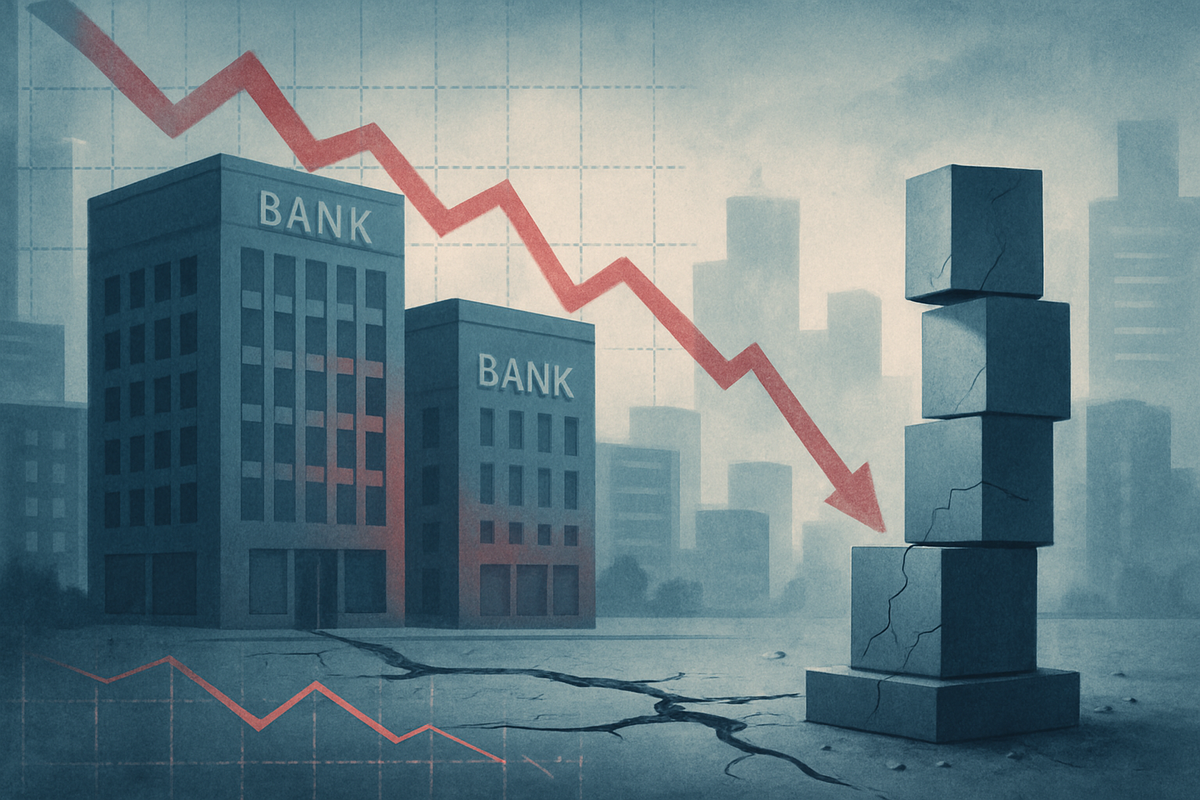
New York, NY – October 16, 2025 – The regional banking sector experienced a significant downturn today, with stocks plummeting across the board as renewed credit worries and specific loan loss disclosures sent shockwaves through the market. This abrupt decline positions regional banks as the day's bottom performers, reigniting fears reminiscent of past financial stresses and overshadowing otherwise strong earnings reports from larger financial institutions. Investors are grappling with concerns over borrower creditworthiness and potential hidden risks within loan portfolios, particularly those tied to commercial real estate.
The immediate catalyst for today's widespread sell-off stemmed from alarming disclosures by two prominent regional players: Zions Bancorporation (NASDAQ: ZION) and Western Alliance Bancorporation (NYSE: WAL). These revelations, coupled with broader anxieties about high interest rates and a challenging economic landscape, painted a grim picture for the sector, prompting a "sell first and ask questions later" mentality among market participants. The downturn underscores a fragile sentiment in an environment where even isolated credit issues can trigger a sector-wide re-evaluation of risk.
Unpacking the Day's Dramatic Decline
The regional banking sector's dramatic decline on October 16, 2025, was largely catalyzed by specific, troubling announcements from individual banks that resonated across the entire industry. Zions Bancorporation (NASDAQ: ZION) saw its shares plunge by as much as 13% after disclosing a $50 million charge-off related to a single borrower within its California Bank & Trust division. Furthermore, the bank announced a $60 million provision for credit losses to be reported in its upcoming third-quarter results, citing "apparent misrepresentations and contractual defaults" by the borrowers involved. Simultaneously, Western Alliance Bancorporation (NYSE: WAL) shares tumbled by 10.5-11% following reports of a collateral dispute with a borrower and exposure to the recent collapse of auto parts maker First Brands Group. Western Alliance also initiated a fraud lawsuit against a borrower for allegedly failing to provide first-position collateral.
These disclosures immediately amplified existing investor unease about the credit quality across the regional banking landscape. The SPDR S&P Regional Banking ETF (NYSEARCA: KRE), a key benchmark for the sector, dropped by 5.6%, marking its largest single-day decline since April 10. Similarly, the KBW Nasdaq Regional Banking Index (NASDAQ: KRX) sank 5.7% in afternoon trading, also its steepest drop since April. This broad market reaction saw other regional banks like Flagstar Financial (NYSE: FLG), Banc of California Inc. (NYSE: BANC), Hingham Institution for Savings (NASDAQ: HIFS), Bank First Corp. (NASDAQ: BFC), Webster Financial (NYSE: WBS), Metropolitan Bank Holding (NYSE: MCB), Axos Financial (NYSE: AX), Great Southern Bancorp Inc. (NASDAQ: GSBC), and Bank OZK (NASDAQ: OZK) experience significant declines ranging from 5% to 8%. The sell-off in regional banking stocks contributed to a broader market dip, with both the S&P 500 and the Dow Jones Industrial Average closing lower. The timeline leading up to this moment includes several recent bankruptcies, such as First Brands Group and subprime lender Tricolor Holdings, which have already highlighted lax lending standards and opaque private credit exposures across the financial system, setting a nervous backdrop for today's events. Key stakeholders involved include the regional banks themselves, their borrowers, investors, and ultimately, the broader economy.
Winners and Losers in a Volatile Market
The current turmoil in the regional banking sector has created a clear delineation of winners and losers. On the losing side are, unequivocally, the regional banks themselves, particularly those with higher exposure to commercial real estate (CRE) and a history of less stringent lending practices. Zions Bancorporation (NASDAQ: ZION) and Western Alliance Bancorporation (NYSE: WAL) are at the forefront of today's losses due to their specific credit disclosures. Other regional banks like Flagstar Financial (NYSE: FLG), Banc of California Inc. (NYSE: BANC), and Bank OZK (NASDAQ: OZK), which are perceived to have higher credit sensitivity or exposure to potentially troubled loan segments, also suffered significant drops. The collective decline suggests that investors are broadly penalizing the sector for perceived systemic credit risks, rather than isolating individual bank issues. Many of these banks are grappling with a disproportionate concentration of CRE loans, which currently faces headwinds from high interest rates, declining property values, and reduced demand for office spaces.
Conversely, while no entity explicitly "wins" from a sector-wide downturn, some market participants may benefit indirectly or be more insulated. Larger, diversified financial institutions like JPMorgan Chase & Co. (NYSE: JPM) or U.S. Bancorp (NYSE: USB), which have recently reported strong third-quarter earnings, appear to be more resilient due to their broader revenue streams, diversified loan portfolios, and stronger capital bases. These larger banks may even see an inflow of deposits or business from customers seeking perceived safety. Furthermore, short-sellers who had positioned themselves against regional bank stocks are likely to be among the financial beneficiaries of today's decline. The broader market sentiment, however, remains cautious, as the regional banking sector's health is often seen as a bellwether for the overall economy, meaning even "winners" might face broader economic headwinds if the situation deteriorates further.
Wider Significance and Ripple Effects
The current distress in the regional banking sector transcends individual bank performance, signaling wider significance and potential ripple effects across the financial landscape. This event fits squarely into broader industry trends marked by an extended period of high interest rates, which pressures borrowers and increases the cost of capital for banks. The persistent vulnerability of the commercial real estate (CRE) sector remains a critical concern; regional banks hold approximately 44% of their total loans in CRE, a stark contrast to the 13% held by larger banks. With office property delinquency rates nearing the 2008 peak of 10.4%, the recent disclosures from Zions and Western Alliance amplify fears that these are not isolated incidents but rather "cracks emerging in borrowers' creditworthiness" within a highly exposed segment.
The potential ripple effects on competitors and partners are substantial. A sustained downturn could lead to tighter lending standards across the board, making it harder for businesses, particularly small and medium-sized enterprises (SMEs) that rely heavily on regional banks, to access capital. This could stifle economic growth and potentially lead to further corporate bankruptcies, creating a negative feedback loop for banks. Regulatory bodies, including the Federal Reserve, are closely watching these developments. While the Fed has been discussing quarter-percentage-point interest rate cuts to support a faltering labor market, the current credit issues might complicate their monetary policy decisions, potentially urging a more cautious approach to rate adjustments or even prompting increased regulatory scrutiny and stress tests for regional banks. Historically, periods of regional bank stress, such as the savings and loan crisis of the late 1980s or the more recent regional bank failures in 2023, have shown how localized credit problems can escalate into broader systemic concerns, necessitating swift and decisive action from regulators and policymakers to restore confidence and stability.
What Comes Next for Regional Banking
Looking ahead, the regional banking sector faces a complex and challenging path. In the short term, investors should brace for continued volatility as the market digests the full extent of credit risks and awaits further disclosures from other regional players. The immediate focus will be on upcoming third-quarter earnings reports, particularly for banks with significant CRE exposure or those that have recently expanded their loan portfolios. Any additional signs of rising loan losses or deteriorating asset quality could trigger further sell-offs. The Federal Reserve's stance on interest rates will also be a critical factor; while rate cuts could eventually ease pressure on borrowers and improve banks' funding costs, the timing and magnitude of such cuts remain uncertain, especially if inflation concerns persist.
In the long term, regional banks may need to consider significant strategic pivots and adaptations. This could include a more aggressive diversification of loan portfolios away from highly concentrated sectors like commercial real estate, stricter underwriting standards, and potentially exploring mergers and acquisitions to achieve greater scale and resilience. Market opportunities may emerge for well-capitalized institutions to acquire distressed assets or consolidate smaller, struggling banks. However, challenges such as maintaining deposit stability in a competitive environment, managing regulatory compliance, and adapting to technological advancements will persist. Potential scenarios range from a gradual stabilization of the sector, perhaps aided by Fed policy and economic recovery, to a more prolonged period of deleveraging and consolidation if credit quality continues to deteriorate. The outcome will largely depend on the broader economic trajectory, the effectiveness of regulatory oversight, and the individual banks' ability to proactively manage their risks and adapt to evolving market conditions.
A Sector at a Crossroads: Key Takeaways and Outlook
Today's sharp downturn in the regional banking sector serves as a stark reminder of the inherent vulnerabilities within the financial system, particularly in an environment marked by elevated interest rates and economic uncertainty. The key takeaway is the renewed emphasis on credit quality and the potential for "hidden" loan losses to emerge, especially within commercial real estate portfolios. The specific disclosures from Zions Bancorporation (NASDAQ: ZION) and Western Alliance Bancorporation (NYSE: WAL) acted as a powerful catalyst, demonstrating how individual credit issues can quickly erode investor confidence across an entire sector. This event highlights that while larger banks may be navigating the current environment with relative ease, their smaller counterparts remain highly susceptible to shifts in borrower creditworthiness and broader economic headwinds.
Moving forward, the market will likely remain highly sensitive to any further news regarding loan losses, particularly those linked to CRE. Investors should closely monitor upcoming earnings reports for all regional banks, paying close attention to provisions for credit losses, non-performing loan ratios, and exposure to vulnerable sectors. The Federal Reserve's monetary policy decisions, especially concerning interest rates, will also play a crucial role in shaping the sector's trajectory. While the current situation presents significant challenges, it also underscores the importance of robust risk management and diversified business models for regional banks. The lasting impact of this event will depend on whether these credit concerns are isolated incidents or harbingers of a more widespread deterioration in asset quality. Investors should remain vigilant, focusing on banks with strong balance sheets, conservative lending practices, and clear strategies for navigating the ongoing economic uncertainties in the months to come.
This content is intended for informational purposes only and is not financial advice






